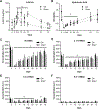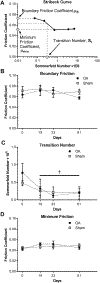Temporal changes in synovial fluid composition and elastoviscous lubrication in the equine carpal fracture model
- PMID: 30859611
- PMCID: PMC6768400
- DOI: 10.1002/jor.24281
Temporal changes in synovial fluid composition and elastoviscous lubrication in the equine carpal fracture model
Abstract
The objective of this study was to examine temporal variations in synovial fluid composition and lubrication following articular fracture. Post-traumatic osteoarthritis (PTOA) was induced by creating an osteochondral fracture in the middle carpal joint of four horses while the contralateral limb served as a sham-operated control. Horses were exercised on a high-speed treadmill, and synovial fluid was collected pre-operatively and at serial timepoints until 75 days post-operatively. Lubricin and hyaluronic acid (HA) concentrations were measured using sandwich ELISAs, and the molecular weight distribution of HA was analyzed via gel electrophoresis. Synovial fluid viscosity and cartilage friction coefficients across all modes of lubrication were measured on days 0, 19, 33, and 61 using a commercial rheometer and a custom tribometer, respectively. HA concentrations were significantly decreased post-operatively, and high molecular weight HA (>6.1MDa) did not recover to pre-operative values by the study termination at day 75. Lubricin concentrations increased after surgery to a greater extent in the OA as compared to sham-operated limbs. Viscosity was significantly reduced after surgery. While boundary and elastoviscous mode friction coefficients did not vary, the transition number, representing the shift between these modes, was lower. Although more pronounced in the OA limbs, similar derangements in HA, HA molecular weight distribution, viscosity, and transition number were observed in the sham-operated limbs, which may be explained by synovial fluid washout during arthroscopy. © 2019 Orthopaedic Research Society. Published by Wiley Periodicals, Inc. J Orthop Res.
Keywords: articular fracture; hyaluronic acid (HA); lubricin/PRG4; post-traumatic osteoarthritis; viscosity.
© 2019 Orthopaedic Research Society. Published by Wiley Periodicals, Inc.
Figures



References
-
- Brown TD, Johnston RC, Saltzman CL, et al. 2006. J Orthop Trauma 20:739–744. - PubMed
-
- Marsh JL, Buckwalter J, Gelberman R, et al. 2002. Articular fractures: does an anatomic reduction really change the result? J Bone Joint Surg Am 84–A:1259–1271. - PubMed
-
- Carbone A, Rodeo S. 2017. Review of current understanding of post-traumatic osteoarthritis resulting from sports injuries. J Orthop Res 35:397–405. - PubMed
Publication types
MeSH terms
Substances
Grants and funding
LinkOut - more resources
Full Text Sources
Medical
Miscellaneous

